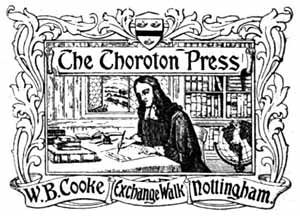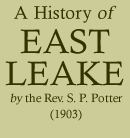< Previous | Contents | Next >
Appendix III.
TRAVELLERS’ NOTES UPON EAST LEAKE.
Throsby in his edition of Thoroton’s Notts., published in 1797, writes:—“East-Leke is a large lordship, open field. Principal proprietors Sir Thomas Parkyns, Bart, and a Mr. Hardy, an inhabitant of this place. The King is the reputed lord of the manor. There are 80 dwellings in this village which lies low: the principal inhabitants are farmers. The Church, which is dedicated to St. Mary, has a spire steeple, 4 bells, 2 side aisles, and is kept clean. The seats, or rather benches, in the Church are ancient; on one, under the reading desk, is a good figure of a Pelican, carved, feeding its young. The Clark of the parish, who was rather chatty informed me that he was nearly the same age of his venerable master, who was then 80 years old; and I add with pleasure, old in good works . . . . .”
Laird in his notes upon Nottinghamshire in “The Beauties of England and Wales,” 1813, describes East Leake as “a large village consisting principally of farm houses; and the Church dedicated to St. Mary is a handsome specimen of the later Gothic, in very good preservation, and having a very handsome turret and spire containing four well toned bells. In the interior which is kept in good order are some ancient benches with curious carvings which seem to have belonged to an older building.”
Potter, T. R., in his “Walks round Loughborough,” 1840, writes, p. 89:—“Leaving Stanford Park on the right, and taking the pathway through the plantation across the road, we soon obtain a sight of East Leake. I think it was Dr. Johnson who observed, that a spire placed in a valley reminded him of an extinguisher. Leake spire has certainly somewhat that appearance. This village lays claim to great antiquity. It is still a substantial and respectable-looking place, and derives importance from the Nottinghamshire Magistrates holding a Petit Session, the Revising Barristers a Court, and there being a great Statute for hiring servants held here.”
Corrigendum.
Since Chapter I. was written and the map printed, further light has fallen upon the Portway (p. 2). From a careful study of the Terrier of 1748, it is plain that this road traversed the parish, roughly, North and South; for it appears in the Hill Field to the North, and Brickliffe Field to the South. In connection with this, and possibly throwing light upon its direction, Mr. Oldershaw recalls ploughing up a paved way, two fields East of Brook Furlong Farm, which apparently ran from the ford at Sheep Plank Lane to Grange Leys Gap, near the meeting place of Costock, Bunney, and East Leake parishes. It may hereafter be shewn that the Crossway was the place where the Streetway and Portway crossed each other. The Crossway has yet to be located.

